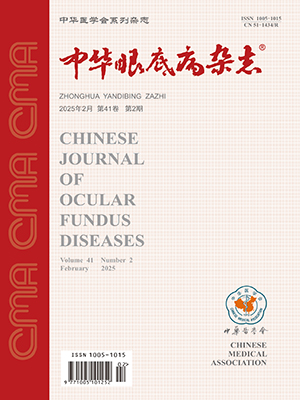| 1. |
Kline LB, Kim JY, Ceballos R. Radiation optic neuropathy[J]. Ophthalmology, 1985, 92(8): 1118-1126. DOI: 10.1016/s0161-6420(85)33898-8.
|
| 2. |
Lessell S. Friendly fire: neurogenic visual loss from radiation therapy[J]. J Neuroophthalmol, 2004, 24(3): 243-250. DOI: 10.1097/00041327-200409000-00014.
|
| 3. |
Danesh-Meyer HV. Radiation-induced optic neuropathy[J]. J Clin Neurosci, 2008, 15(2): 95-100. DOI: 10.1016/j.jocn.2007.09.004.
|
| 4. |
Guy J, Mancuso A, Beck R, et al. Radiation-induced optic neuropathy: a magnetic resonance imaging study[J]. J Neurosurg, 1991, 74(3): 426-432. DOI: 10.3171/jns.1991.74.3.0426.
|
| 5. |
Bach M, Kommerell G. Determining visual acuity using European normal values: scientific principles and possibilities for automatic measurement[J]. Klin Monbl Augenheilkd, 1998, 212(4): 190-195. DOI: 10.1055/s-2008-1034863.
|
| 6. |
Pan L, Qu B, Bai J, et al. The Zap-X radiosurgical system in the treatment of intracranial tumors: a technical case report[J/OL]. Neurosurgery, 2021, 88(4): E351-355[2021-03-15]. https://pubmed.ncbi.nlm.nih.gov/33442727/. DOI: 10.1093/neuros/nyaa550.
|
| 7. |
Van Den Bergh AC, Hoving MA, Links TP, et al. Radiation optic neuropathy after external beam radiation therapy for acromegaly: report of two cases[J]. Radiother Oncol, 2003, 68(2): 101-103. DOI: 10.1016/s0167-8140(03)00201-9.
|
| 8. |
Danesh-Meyer HV, Savino PJ, Sergott RC. Visual loss despite anticoagulation in radiation-induced optic neuropathy[J]. Clin Exp Ophthalmol, 2004, 32(3): 333-335. DOI: 10.1111/j.1442-9071.2004.00825.x.
|
| 9. |
Garrott H, O'day J. Optic neuropathy secondary to radiotherapy for nasal melanoma[J]. Clin Exp Ophthalmol, 2004, 32(3): 330-333. DOI: 10.1111/j.1442-9071.2004.00824.x.
|
| 10. |
Boschetti M, De Lucchi M, Giusti M, et al. Partial visual recovery from radiation-induced optic neuropathy after hyperbaric oxygen therapy in a patient with Cushing disease[J]. Eur J Endocrinol, 2006, 154(6): 813-818. DOI: 10.1530/eje.1.02161.
|
| 11. |
Levy RL, Miller NR. Hyperbaric oxygen therapy for radiation-induced optic neuropathy[J]. Ann Acad Med Singap, 2006, 35(3): 151-157.
|
| 12. |
Demizu Y, Murakami M, Miyawaki D, et al. Analysis of vision loss caused by radiation-induced optic neuropathy after particle therapy for head-and-neck and skull-base tumors adjacent to optic nerves[J]. Int J Radiat Oncol Biol Phys, 2009, 75(5): 1487-1492. DOI: 10.1016/j.ijrobp.2008.12.068.
|
| 13. |
Ballian N, Androulakis II, Chatzistefanou K, et al. Optic neuropathy following radiotherapy for Cushing's disease: case report and literature review[J]. Hormones (Athens), 2010, 9(3): 269-273. DOI: 10.1007/bf03401278.
|
| 14. |
Mayo C, Martel MK, Marks LB, et al. Radiation dose-volume effects of optic nerves and chiasm[J]. Int J Radiat Oncol Biol Phys, 2010, 76(3 Suppl): S28-35. DOI: 10.1016/j.ijrobp.2009.07.1753.
|
| 15. |
Zhao Z, Lan Y, Bai S, et al. Late-onset radiation-induced optic neuropathy after radiotherapy for nasopharyngeal carcinoma[J]. J Clin Neurosci, 2013, 20(5): 702-706. DOI: 10.1016/j.jocn.2012.05.034.
|
| 16. |
Kim IK, Lane AM, Egan KM, et al. Natural history of radiation papillopathy after proton beam irradiation of parapapillary melanoma[J]. Ophthalmology, 2010, 117(8): 1617-1622. DOI: 10.1016/j.ophtha.2009.12.015.
|
| 17. |
张燕, 李红阳, 彭春霞, 等. 放射性视神经病变的诊疗特征[J]. 国际眼科杂志, 2014, 14(6): 1095-1099. DOI: 10.3980/j.issn.1672-5123.2014.06.31.Zhang Y, Li HY, Peng CX, et al. Diagnosis and treatment characteristics of radioactive optic neuropathy[J]. Int Eye Sci, 2014, 14(6): 1095-1099. DOI: 10.3980/j.issn.1672-5123.2014.06.31.
|
| 18. |
Guy J, Fitzsimmons J, Ellis EA, et al. Gadolinium-DTPA-enhanced magnetic resonance imaging in experimental optic neuritis[J]. Ophthalmology, 1990, 97(5): 601-607. DOI: 10.1016/s0161-6420(90)32536-8.
|
| 19. |
Piquemal R, Cottier JP, Arsène S, et al. Radiation-induced optic neuropathy 4 years after radiation: report of a case followed up with MRI[J]. Neuroradiology, 1998, 40(7): 439-441. DOI: 10.1007/s002340050619.
|
| 20. |
Archer EL, Liao EA, Trobe JD. Radiation-induced optic neuropathy: clinical and imaging profile of twelve patients[J]. J Neuroophthalmol, 2019, 39(2): 170-180. DOI: 10.1097/wno.0000000000000670.
|
| 21. |
Wijers OB, Levendag PC, Luyten GP, et al. Radiation-induced bilateral optic neuropathy in cancer of the nasopharynx. Case failure analysis and a review of the literature[J]. Strahlenther Onkol, 1999, 175(1): 21-27. DOI: 10.1007/bf02743457.
|




